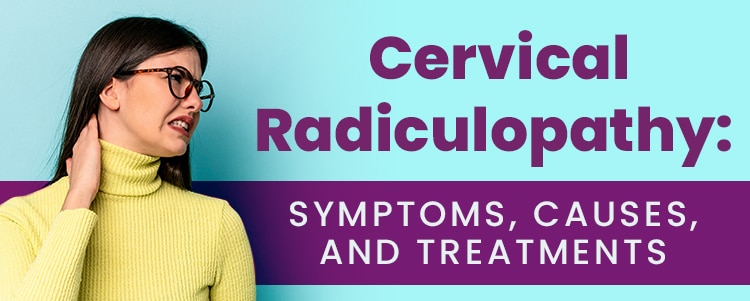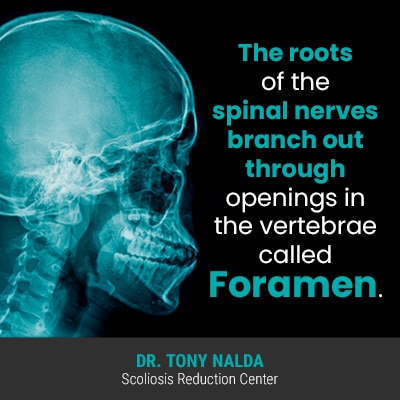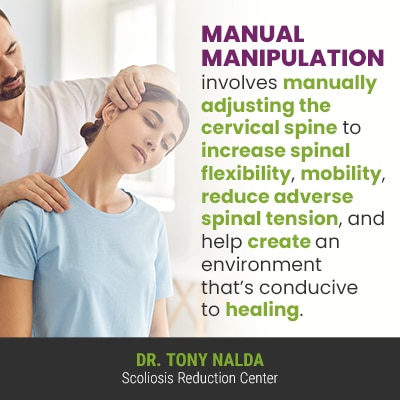
The spine is made up of vertebrae (bones) stacked on top of one another and separated by intervertebral discs. The cervical spine (neck) contains 7 of these vertebrae that start at the base of the skull. Also called a pinched nerve, when there is a change in how a nerve functions due to a damaged nerve root in the cervical spine, this is cervical radiculopathy.
Cervical radiculopathy is a condition marked by compression of one or more nerve roots in the cervical spine; as a result, affected nerve roots can become irritated and impact its neurological function. Symptoms include radicular pain, weakness/numbness. Causes/treatment options are case-specific.
Let’s start our discussion of cervical radiculopathy with some basic spinal anatomy and facts about the cervical spine.
Table of Contents
There are three main sections of the spine: cervical (neck), thoracic (middle/upper back), and lumbar spine (lower back).
In a healthy spine, each section has a characteristic curvature type, and when viewed from the front and back, the spine will appear straight, but when viewed from the sides, it will have a soft ‘S’ shape.
The spine is naturally curved because it makes it stronger, more flexible, and better capable to absorb/distribute mechanical stress that’s incurred during movement.
As the spine works in tandem with the brain to form the central nervous system (CNS) and facilitate brain-body communication, spinal conditions can disrupt the sending/receiving of messages that control thoughts, senses, movement, and reflexes.
The cervical spine consists of 7 vertebral bodies, and the C5 and C6 vertebrae are commonly referred to as the stress vertebrae because they have to support the weight of the neck and head.
 The roots of the spinal nerves branch out through openings in the vertebrae called foramen.
The roots of the spinal nerves branch out through openings in the vertebrae called foramen.
An important characteristic of spinal nerves, and nerves in general, is that they are like limbs of a tree, branching off in multiple directions, which is why radicular pain can be felt far from its site of origin.
When a nerve root is exposed to uneven pressure (compression), it can become irritated, inflamed, and/or damaged.
When we look at the nerves that run through the cervical spine, these nerves send messages between the muscles and the brain, affecting musculoskeletal reflexes.
If the nerve roots of the cervical spine are damaged, cervical radiculopathy can cause a number of symptoms felt anywhere along the pathway of the affected nerve.
Cervical Radiculopathy Symptoms
Damaged nerve roots in the cervical spine can cause a variety of symptoms with varying degrees of severity.
Radicular pain can be felt anywhere along the compressed nerve’s pathway, potentially far from the site of original nerve compression: into the arm, neck, chest, shoulders, upper back, and/or hand.
Where radicular pain is likely to be felt is dependent upon the location of the damaged nerve root(s), and in many cases, the pain only affects one side of the body.
In addition, cervical radiculopathy can also cause sensory issues such as tingling and/or numbness in the fingers or hands, and motor problems such as lack of coordination, muscle weakness, and/or a loss of reflexes in the arms or legs.
Now that we have defined the condition and discussed some of its common symptoms, let’s move on to causation.
So we know that cervical radiculopathy involves damaged nerve roots, but how do the nerve roots in the cervical spine become damaged?
As is the case with most spinal conditions, there are multiple causes of cervical radiculopathy from spinal degeneration, a herniated disc, arthritis, and injury that puts pressure on the nerve roots in the neck.
Spinal degeneration is a contributing factor in the development of many spinal conditions.
While there is a certain amount of spinal degeneration to be expected with age, lifestyle factors can also play a role: carrying excess weight, low activity levels, chronic poor posture, and repeatedly lifting heavy objects incorrectly.
Carrying excess weight puts more pressure on the joints of the body, including the spine, and this can increase rates of spinal degeneration by making the spine work harder to support the weight of the body.
In addition, the very design of the spine is based on movement, so leading a sedentary lifestyle can affect the spine’s overall health and function, and in particular, the intervertebral discs need movement to increase surrounding circulation as they don’t have their own vascular supply.
Chronic poor posture can affect the spine’s biomechanics by putting strain on the spine and its surrounding muscles. Forward head posture, for example, also known in the modern age as tech neck, increases the weight of the head on the cervical spine, putting more pressure on the vertebrae, muscles, and nerves.
People who have occupations that involve repeatedly lifting heavy objects need to be educated on the ergonomics of proper lifting so that no one section of the spine is exposed to excessive strain or put at risk of injury.
Cervical Disc Herniation
Most commonly after the age of 40, people start to experience varying levels of spinal degeneration, and in most cases, it’s the intervertebral discs that are the first spinal structures to deteriorate.
The intervertebral discs sit between adjacent vertebrae and have a tough outer layer called the annulus and a soft gel-like interior called the nucleus.
The discs provide the spine with structure, flexibility, and act as the body’s shock absorbers so mechanical stress is evenly distributed along the spine.
When a disc starts to deteriorate, it can change shape, affecting the position of adjacent vertebrae, which can impact nearby nerve roots.
Deteriorating discs are also at risk of becoming desiccated, bulging, and/or herniated, and when a disc herniates, this means its inner nucleus is pushing its way through the outer annulus and is impinging on the nerve space within the spine.
Once a cervical disc’s inner material has leaked out, it can inflame and irritate the adjacent nerve and cause cervical radiculopathy.
Herniated discs are most likely to be caused by strenuous activities or injuries, making it the most common cause of cervical radiculopathy in young adults.
Another spinal condition known to cause cervical radiculopathy is stenosis.
Cervical Foraminal Stenosis
The foramen are the bony openings in the spinal canal through which nerve roots pass.
If for some reason, these openings become smaller, it leaves less space for the nerve roots and can cause them to become compressed and/or impinged.
So cervical foraminal stenosis is the narrowing of space within the spinal canal, leaving less space for the nerve roots within, and pressing on them causing inflammation, irritation, compression, and/or impingement.
Additional spinal conditions such as cervical osteoarthritis and cervical degenerative disc disease can cause the development of bone spurs (bone growths on the edges of bones), thickening ligaments, and/or a herniated disc: all result in nerve roots in the foramen being pushed against unevenly.
While the aforementioned causes are the most common, there are some additional ones worth mentioning:
Now that we understand some of the common causes of cervical radiculopathy, let’s address the important question of how to treat it moving forward.
There are many different types of treatment for cervical radiculopathy, and treatment plans will be based largely on the condition’s underlying cause and the severity of symptoms.
Treatment plans will often involve integrating multiple forms of treatment for the best potential results.
Let’s break down the different nonsurgical forms of treatment available for those diagnosed with cervical radiculopathy.
Rest/Activity Modification/Postural Correction
Rest and activity modification addresses some of the lifestyle choices that directly affect overall spinal health and function that we discussed earlier.
Part of my role as a scoliosis chiropractor here at the Scoliosis Reduction Center is to assess the health and function of the entire spine, not just the area directly affected; we know that what’s happening in one section of the spine can also affect other sections, not to mention other parts of the body.
Part of my assessment of cervical radiculopathy patients is to determine which, if any, lifestyle choices are exacerbating the condition.
If a patient is carrying excess weight that is straining the spine, providing guidance on how to lose the weight in a healthy way, plus dietary changes, can be a component of treatment.
In addition, if lack of activity is an issue, custom-prescribed condition-specific exercises that work towards increasing spinal strength, flexibility, and increasing surrounding muscle strength so the cervical spine is optimally supported can also be a valuable part of treatment.
Providing guidance on the types of activities that might be too strenuous and should be limited or avoided, particularly lifting heavy objects, can also be helpful by ensuring the spine has time to heal and recover.
I can also tell a lot about a person’s spinal health by the way they walk and their overall posture. As part of a physical exam, I can help patients work towards correcting bad posture in the interest of preserving spinal health and function.
Hot/Cold Therapy
Part of the treatment for cervical radiculopathy will involve pain management, and as mentioned, symptom severity, as well as the underlying cause, guides the design of effective treatment plans.
If a patient is experiencing pain and discomfort, I like to start with the least invasive forms of treatment first, one of which is hot/cold therapy.
Applying an ice pack or heated gel pack to the neck during times of discomfort can provide relief for those with milder symptoms.
For example, applying cold therapy during a flare-up that’s activity-related can help reduce pain and inflammation, and hot therapy can help to keep the cervical spine and its surrounding muscles as relaxed as possible.
Physical therapy is a form of treatment that focuses on physical treatment methodologies such as massage, hot/cold therapy, and condition-specific exercises, rather than more-invasive methods such as medications and/or surgery.
A physical therapist can design an exercise/stretching routine that addresses the specifics of each patient and their condition.
When designed and custom-prescribed by a professional, condition-specific stretches and exercises can help improve neck/back strength and flexibility, which can help with postural correction and pain management.
Chiropractic Care
There are a number of chiropractic techniques I use to treat cervical radiculopathy.
 Manual manipulation involves manually adjusting the cervical spine to increase spinal flexibility, mobility, reduce adverse spinal tension, and help create an environment that’s conducive to healing.
Manual manipulation involves manually adjusting the cervical spine to increase spinal flexibility, mobility, reduce adverse spinal tension, and help create an environment that’s conducive to healing.
Another effective chiropractic technique is cervical traction. Cervical traction involves the use of a device that uses the gentle application of weight to slightly raise the head.
Extending the cervical spine gently by raising the head can help increase the space between each of the cervical vertebrae, particularly in the foramen through which the nerve roots pass.
For patients who find cervical traction in a clinical environment particularly helpful in terms of pain management, the use of a home traction device can be prescribed.
In many cases of mild cervical radiculopathy, symptoms resolve on their own, especially if lifestyle changes are involved.
Most patients find success with an integrative treatment approach, rather than a singular approach.
So now that we have addressed many of the clinical aspects of cervical radiculopathy including diagnosis and treatment, let’s talk about exercises that can be done from home to augment treatment and keep the cervical spine as healthy as possible.
While no exercises should be attempted before checking with the cervical radiculopathy treatment provider, the following exercises can be easily performed at home, while sitting or standing, and when done effectively, can help augment treatment and manage symptoms.
Cervical radiculopathy exercises can help keep the cervical spine as loose and flexible as possible, not to mention increasing the strength of muscles surrounding the spine that help provide it with support and stabilization.
Exercises that involve gentle cervical extension can also help with creating more space within the spine for the nerves within, and when this occurs, pressure on affected nerve roots can be reduced.
Here are 3 effective cervical radiculopathy exercises:
A chin tuck with extension can help cervical radiculopathy by gently stretching the cervical spine and reducing tension in the neck muscles; this can also improve posture in the neck and head.
Steps for Performing a Chin Tuck with Extension
The trap stretch targets the trapezius muscles at the back of the neck. When these muscles are tight, they can cause compression of the spine and its nerves.
When performed properly, a trap stretch can loosen the trapezius muscles and free trapped nerves.
Steps for Performing a Trap Stretch
As mentioned earlier, cervical radiculopathy can cause a wide variety of symptoms felt throughout the body, including the shoulders.
Shoulder rolls can be effective at releasing tension in the neck and shoulders, which also helps relieve pressure and pain caused by a pinched nerve.
Steps for Performing a Shoulder Roll
Performing some simple and effective neck stretches can be a safe and non-invasive way to manage pain and augment other forms of treatment.
For those experiencing radicular pain, it can be difficult to get a good night’s rest, and this can exacerbate the condition as a well-rested body is one that’s going to be more responsive to treatment and better able to heal itself.
For those who have experienced back pain, and specifically, pain in the neck, keeping up with daily tasks and responsibilities can be a challenge, and when that pain is disrupting healthy sleep patterns, it can greatly impact the quality of life.
Pain can make it difficult to relax enough to fall asleep, and it can also make it impossible to find a comfortable sleep position, and poor sleep posture can actually exacerbate the condition.
When it comes to the best way to sleep with cervical radiculopathy, we’re talking about how to manage pain, find a comfortable sleep position, and properly position the head and neck for optimal cervical spinal alignment and biomechanics.
The best sleep positions for people with cervical radiculopathy are the same for people without spinal issues as they promote a healthy and neutral spinal alignment, but of course, for people with spinal conditions, it’s even more important to develop healthy sleep posture and habits.
Sleeping flat on the back is the optimal sleep position for anyone, and particularly those with cervical radiculopathy as it’s the best position for properly supporting the head and positioning of the neck.
Sleeping flat on the back doesn’t expose the spine to any uneven pressure and keeps the spine neutral and aligned.
It’s also helpful to find a cervical pillow that reinforces the natural curvature of the neck and pads the head for comfort.
After sleeping on the back, side sleeping is the next-best sleep position. The most important thing to remember for side sleepers is to use a tall pillow to help promote optimal cervical alignment with the head and the rest of the spine.
Using a tall pillow when side sleeping can help keep the spine straight and aligned throughout the night.
Sleeping on the stomach is the worst position for promoting spinal alignment, and in terms of cervical radiculopathy, this position involves having to twist the neck unnaturally to rest the head on the pillow.
However, if this is the only position that’s comfortable, a thin pillow or no pillow, should be used to avoid contorting the neck into unnatural angles.
Sleeping in an upright position isn’t for everyone, but for those suffering from intense back and/or neck pain, it can be helpful at relieving pressure points.
People choosing to sleep upright will benefit from foregoing a traditional pillow in favor of a u-shaped pillow wrapped around the neck, and a smaller pillow to support the lower back.
The spine is a key structure of human anatomy as the body’s central support structure; it allows us to stand upright, practice good posture, engage in flexible movement, and absorb stress from movement and impact.
As the spine works in tandem with the brain to form the body’s central nervous system, the health and function of the spine impacts virtually every working system within the body.
The spinal nerves are mixed nerves because they carry sensory, motor, and autonomic messages between the spinal cord and the rest of the body.
If a nerve in the cervical spine becomes irritated, inflamed, compressed, and/or impinged upon, it can become damaged and cause a variety of symptoms including radicular pain felt in the neck, back, shoulders, arms, and hands.
Coordination and reflex response can also be affected, and muscle weakness can also develop.
If a nerve in the cervical spine is damaged to the point of causing pain and disrupting its neurological function, this is diagnosed as cervical radiculopathy.
Most commonly, cervical radiculopathy is caused by spinal degeneration, a herniated disc, an injury, or a variety of spinal conditions such as osteoarthritis and stenosis.
When it comes to treating cervical radiculopathy, here at the Scoliosis Reduction Center, I apply an integrative chiropractic-centered approach that focuses on providing lifestyle guidance, postural correction when necessary, physical therapy, and a variety of chiropractic techniques such as manual manipulation and cervical traction.
